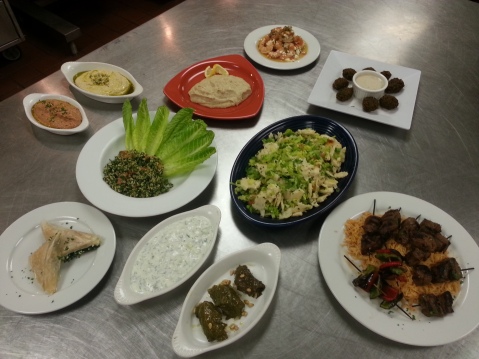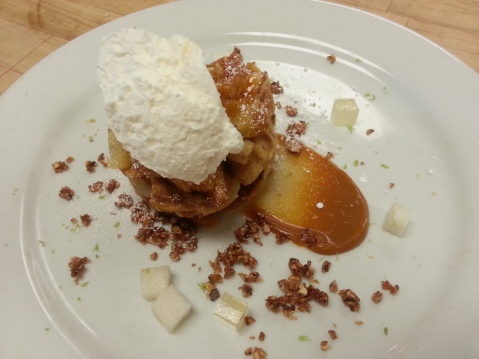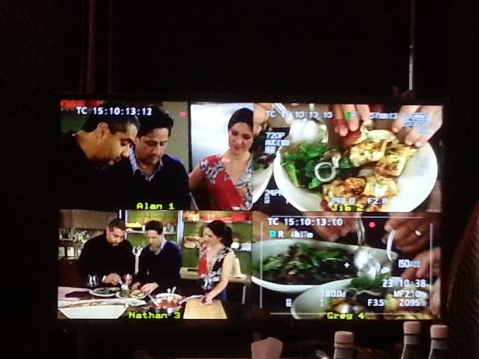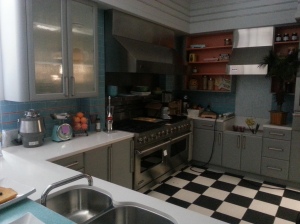“Frosting a Chocolate Cake . . . Nude”
That’s the name of one of the new videos from Hungry Channel, the Food Network’s new(ish) Youtube channel. Nice to see what one can get away with in the food media world, sans regulations. Make sure to watch with the sound on!
Cuisines Across Cultures (the Real Kitchen version)
 This past weekend, I stopped into my uncle’s new bakery. It’s a Chinese bakery (think bbq pork buns, pineapple bread, egg custard tarts, curry chicken puffs, etc.), located in a Vietnamese mall, and all the baking is done by a bunch of Mexican guys. Hence the title of this post. I spent some time in the kitchen watching these guys make Taro Buns at breakneck speed — each purple sphere consists of a ball of sweet taro paste wrapped in a delicate flaky marbled taro pastry, baked. The skill and accuracy with which these guys (with whom I of course couldn’t communicate given I don’t speak the universal language of the American restaurant kitchen) kneaded the taro dough, molded the paste, and deftly enveloped each taro ball in the light dough, closed off with a twist, would’ve put many a Chinese grandma to shame.
This past weekend, I stopped into my uncle’s new bakery. It’s a Chinese bakery (think bbq pork buns, pineapple bread, egg custard tarts, curry chicken puffs, etc.), located in a Vietnamese mall, and all the baking is done by a bunch of Mexican guys. Hence the title of this post. I spent some time in the kitchen watching these guys make Taro Buns at breakneck speed — each purple sphere consists of a ball of sweet taro paste wrapped in a delicate flaky marbled taro pastry, baked. The skill and accuracy with which these guys (with whom I of course couldn’t communicate given I don’t speak the universal language of the American restaurant kitchen) kneaded the taro dough, molded the paste, and deftly enveloped each taro ball in the light dough, closed off with a twist, would’ve put many a Chinese grandma to shame.
Cuisines Across Cultures (the Classroom Kitchen version)
Sorry I’ve been MIA! Having been scolded, I’m back.
 Since returning from Spring Break, we started our latest segment in culinary school: Cuisines Across Cultures. In this class, we learn about, and then cook, the cuisine of one “culture” every other day. In between during down-days, we also get to learn about and taste (at least those of us over age 21) wine.
Since returning from Spring Break, we started our latest segment in culinary school: Cuisines Across Cultures. In this class, we learn about, and then cook, the cuisine of one “culture” every other day. In between during down-days, we also get to learn about and taste (at least those of us over age 21) wine.
Cuisines Across Cultures is taught by Chef L, who is Israeli and pretty badass. He’s serious, but in a good way. That said, it took everyone (including me) some adjustment time to get back in the groove after our mini-vacation in Baking & Pastry. Gone are the days of casually rolling out dough, waiting for it to rise, strolling down to Starbucks to get a latte, playing with molding chocolate, etc. Back are the days of super tight timelines, cooking 8 things at once, being told repeatedly that my food isn’t salty enough, and walking around with a ton of burn scars all over my hands and arms. Feels like home 😉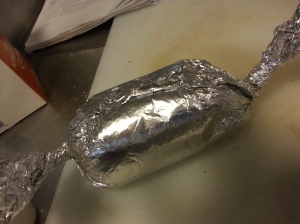
Though the class has been good so far (lots of substantive knowledge), the things we’ve cooked haven’t been. The format of the class is such that we progress from the least exotic to the most, at least in some sensibilities, and so we spent the first two weeks cooking our way through Italy, Germany, Austria, and France — sadly, kinda snoozy. The funnest thing was this crazy meat roll, Schweinelendchen im Schwarzbratmantel, of Austrian origin: Take a piece of pork tenderloin, sear it, and then roll it in a mixture of . . . more ground pork. Wrap the thing in aluminum foil, twist up the sides like a tootsie roll (see photo), and poach the crap out of it until it’s completely and utterly flavorless. Serve sliced. Heavens only knows why someone would come up with the idea of taking one piece of pork and rolling it in more ground pork. Sigh.
So that’s why i’m low on pictures. We cooked our way through Spain after that, which was great (4 kinds of tapas, plus paella), so great I forgot to take pics. The one cooking tip I have on that? During cooking, paella should 1) never be covered; and 2) never be stirred. Doing either of those things creates a mushy rice mixture — the last thing you want in classical paella.
As I said, the food has gotten more exotic as class has progressed. This week, we’re on to Africa. Depicted top left: Chicken Tagine (N. African), Black-eyed Pea Fritters (W. African), Grilled Tamarind Fish with Coconut Sauce (E. African), and Stewed Eggplant (S. African). Then, the Middle East. Depicted above: Hummus (shelling chickpeas by hand, one by one, is miserable, but really does produce an ultra smooth and delicious hummus), Red Pepper Walnut Spread, Tabbouleh, Fatoush, Lamb Shish Kebab with Rice and Raita, Dolma, Baba Ghannoush, Spanikopita (turns out there IS such a thing as too much butter on filo dough; prevents the dough from browning), fresh Pita, Saganaki, and Falafel with Tahini Sauce.
Humuhumunukunukuapua’a
Some of you may recognize this word from Forgetting Sarah Marshall. (Quote from the chubby Hawaiian hotel bartender: “I can name a gazillion different kinds of fish . . . including Hawai’i’s official state fish, humuhumunukunukuapua’a. Bitch.”) The chubby bartender is right; the trigger fish, as it’s more commonly known, was previously designated Hawaii’s official state fish. But the locals call it by its Hawaiian name, which is far more fun to say and which, apparently, translates to “Fish that grunts like a pig.” Ha.
 That is actually a dumb caption for this post, since it has nothing to do with anything, but it was just too hard to resist. This post, instead, is about Sheldon Simeon, executive chef of Star Noodle on Maui and recent runner-up and fan-favorite of Top Chef Seattle. Stopping by his restaurant was of course a must-do during our trip to Maui, so we popped in on Friday night to scarf down some noodles and hopefully catch a glimpse of him. (With the exception of a ribeye dish intended for two, there is no single item on his menu that exceeds $15. Awesome.)
That is actually a dumb caption for this post, since it has nothing to do with anything, but it was just too hard to resist. This post, instead, is about Sheldon Simeon, executive chef of Star Noodle on Maui and recent runner-up and fan-favorite of Top Chef Seattle. Stopping by his restaurant was of course a must-do during our trip to Maui, so we popped in on Friday night to scarf down some noodles and hopefully catch a glimpse of him. (With the exception of a ribeye dish intended for two, there is no single item on his menu that exceeds $15. Awesome.)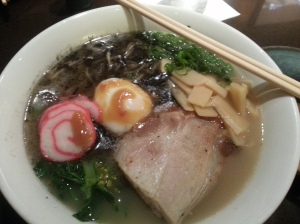
We were told as soon as we got there that “Chef Sheldon has already left for the night.” We hadn’t really expected to see him anyway — everyone says that a formidable showing on Top Chef changes the contestants’ lives post-competition, and they are thereafter inundated with public appearances and such. Indeed, we’d seen Sheldon’s picture at least 4 times in various papers, magazines, and fliers for various food events during our week in Maui. Nevertheless, we thought it appropriate to console ourselves by ordering nearly everything on his menu.
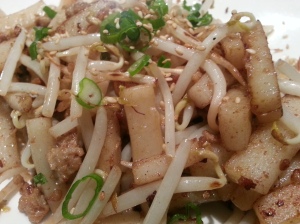 Depicted here (this is NOT everything we ordered, not even close): 1) Vietnamese crispy creme with shrimp and bean sprouts; 2) Classic tonkotsu ramen with housemade mayou (Asian dark sesame oil); 3) Lahaina fried soup consisting of pork, bean sprouts, and stir-fried chow fun, a Sheldon family tradition made using tapioca noodles, which retains its chew (or, as we Taiwanese like to say, it’s “Q-ness”) even when cooled (and no, don’t ask me why it’s called “soup” when there’s no soup); and the best of all, 4) Sheldon’s Filipino “Bacon and Eggs” made of seared pork belly, fried onions, and a 62-degree egg that was served on a sizzling hot plate. Every single item was amazing. Truly.
Depicted here (this is NOT everything we ordered, not even close): 1) Vietnamese crispy creme with shrimp and bean sprouts; 2) Classic tonkotsu ramen with housemade mayou (Asian dark sesame oil); 3) Lahaina fried soup consisting of pork, bean sprouts, and stir-fried chow fun, a Sheldon family tradition made using tapioca noodles, which retains its chew (or, as we Taiwanese like to say, it’s “Q-ness”) even when cooled (and no, don’t ask me why it’s called “soup” when there’s no soup); and the best of all, 4) Sheldon’s Filipino “Bacon and Eggs” made of seared pork belly, fried onions, and a 62-degree egg that was served on a sizzling hot plate. Every single item was amazing. Truly.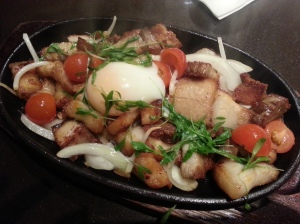
Even more amazing? I’m mid-gobble, look up, and there’s Sheldon. Not in his now-signature red cap (from American Apparel, as I learned), but in a blue version of the same. And he is totally cool. Spent no less than 15 minutes sitting with us at the bar and chatting us up, inviting us to come eat his sweet potato leaves appetizer that he’s doing for another food event the next day, explaining to us that the ramen pork bone broth is made from the carcass of the giant pig that we incidentally ate at Old Lahaina Lu’au the very night before (same ownership), and just generally being wholly down-to-earth, humble, friendly, and a really nice guy. He told us that Urbana — the restaurant concept that he’d done for the “restaurant wars” episode of Top Chef — is something he’d genuinely like to do (perhaps in San Francisco!), and that the fact that I work with Off the Grid is “legit” cuz the organization has done a lot for the gourmet street food movement. Yay.
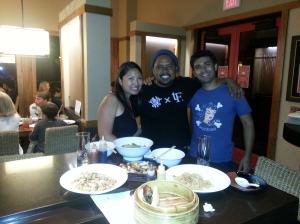 There’s really something to be said for liking someone so much on TV, meeting them in person, and then finding out that they are every bit as cool as they’d seemed. I’ll be rooting for him.
There’s really something to be said for liking someone so much on TV, meeting them in person, and then finding out that they are every bit as cool as they’d seemed. I’ll be rooting for him.
The “Real” Hawaiian Pizza . . .
. . . was good, but it didn’t taste much different from what we get stateside. 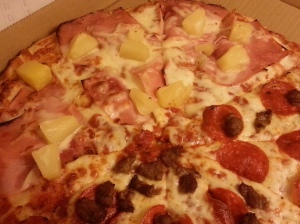
For Spring Break — yes, as a born-again student, I, too, get Spring Break, “chefs gone wild” style — A and I spent 7 days in gorgeous Maui. One of our must-dos was to order a hawaiian pizza, which I have never really been a fan of but wanted to try there because it’s kitschy and dumb and awesome all at the same time. We picked up a large half-Hawaiian/half-meat lovers’ from Pizza Paradiso, supposedly one of the best pizza joints on the island, and while it was good (the Canadian bacon was noticeably less salty), it didn’t do all that much for me. Now that we’re back on the mainland (that “mainland” lingo caught me off guard at first; a grocery store clerk asked me if I was “from the mainland,” and my Taiwanese blood immediately prickled until I realized that he was referring to the continental U.S. and now evil communist China), we’ll likely stick with margherita.
Luce. Wah, wah.
You’ve probably figured out from my title that I didn’t win the Luce competition. Instead, the grand prize (which, as they informed us less than 24 hours before the awards ceremony, was no longer a trip to Aspen Food and Wine but instead some way-less-fun-sounding dinner-for-the-press dinner in New York) went to my competitor Juliet Fine, who admittedly did an amazing job. (Honestly, I would’ve been way more annoyed if someone other than her had won.) I did, however, get an awesome trophy of a 4-inch-tall gold-plated chef, with the plaque captioned: Runner-Up. hahaha.
Of course I’m disappointed. I’m human, and the judges were on camera saying that my meal was the best. But of course there’s a huge kitchen component to it as well, and I undoubtedly screwed up here and there (the 1,076 gnocchi that I accidentally sent to pasta heaven come to mind). Juliet is a far more skilled chef, having gone through multiple culinary programs and apprenticed at Alice Waters’ Chez Panisse. So I have no doubt she showed more command in the kitchen. She’s one that I will be keeping tabs of…
Regardless, the Luce competition was truly one of the most amazing experiences in my life — definitely up there in the Top 3. A year ago, sitting in my office and reworking a class certification brief, I never in a million years would’ve dreamed that I would have the opportunity to open a Michelin-starred restaurant, have its amazing staff, kitchen, ingredients, wines, etc., at my disposal, and serve a 3-course menu that I had personally conceived of, to the public. And that so many of my close friends and family got to personally taste my food at its very best.
No regrets, far from it. Thanks to all for your support!!
“Shoe Dough”
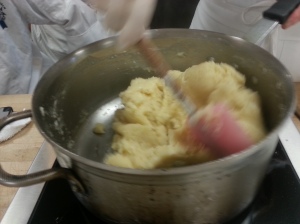 While I’m trying to stay away from these purely instructional (read: boring-er) posts, Pate a Choux (“pod a shoe” — or, as most of my classmates thought it was called/spelled, “shoe dough”) is just so commonly used, and so commonly fucked up, that I have to include a brief post on it. Pate a Choux is the dough used to make cream puffs and eclairs, as well as certain savory items (sometimes the dough it mixed with mashed potatoes and then fried up to form light airy potato puffs).
While I’m trying to stay away from these purely instructional (read: boring-er) posts, Pate a Choux (“pod a shoe” — or, as most of my classmates thought it was called/spelled, “shoe dough”) is just so commonly used, and so commonly fucked up, that I have to include a brief post on it. Pate a Choux is the dough used to make cream puffs and eclairs, as well as certain savory items (sometimes the dough it mixed with mashed potatoes and then fried up to form light airy potato puffs).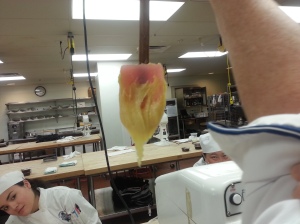
It’s actually a super simply dough to make, but time and again I hear people complaining about how they screwed it up “that one time” and will never venture to try again. Please don’t be one of those.
 It’s actually really easy. Key is to first bring the water and butter to a boil — don’t just melt the butter, actually bring the thing to a boil — then take it off the heat, add your flour, put it back over a low flame and mix CONTINUOUSLY with a spatula, not a whisk. Sign it’s getting close to done: the dough starts pulling away from the sides of the pan (see photo). Unfortunately, that’s only the sign that it’s close; lots of people stop there and then they ask why their dough doesn’t rise in the oven when baked. In order to completely cook the flour that you’ve added, as well as cook out any extraneous water that may weigh down your dough, you gotta keep mixing over low heat. Sign that it’s ACTUALLY done: When you lift the spatula, the dough forms a point at the end (see photo).
It’s actually really easy. Key is to first bring the water and butter to a boil — don’t just melt the butter, actually bring the thing to a boil — then take it off the heat, add your flour, put it back over a low flame and mix CONTINUOUSLY with a spatula, not a whisk. Sign it’s getting close to done: the dough starts pulling away from the sides of the pan (see photo). Unfortunately, that’s only the sign that it’s close; lots of people stop there and then they ask why their dough doesn’t rise in the oven when baked. In order to completely cook the flour that you’ve added, as well as cook out any extraneous water that may weigh down your dough, you gotta keep mixing over low heat. Sign that it’s ACTUALLY done: When you lift the spatula, the dough forms a point at the end (see photo). 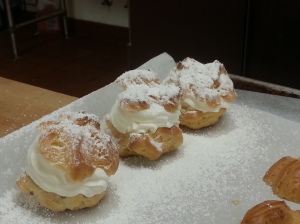
Now, just remove the dough from the heat, put it into a cool bowl, and mix (either by hand or super-low by machine) in enough eggs to where it gets to the right consistency — just barely sticky/tacky. When you first add the eggs, your doughball will look gloppy and gross — don’t give up! It’s just testing you to see how badly you really want to eat those homemade cream puffs. Keep at it, and it’ll all come together. I promise.
Next, just pipe using a star tip. Circles will give you cream puffs, logs will give you eclairs. Ta-da!
“Open the Oven Door Again, Will Ya?”
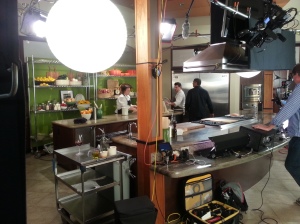 Last week, Cook Taste Eat, the new online video food magazine I’ve been working with, did its quarterly video shoot. (They shoot all of the videos for 3 months in the span of one week.) Despite having nothing at all to contribute to the video production side of things, I stopped by the shoot anyway to catch a glimpse of how it all works.
Last week, Cook Taste Eat, the new online video food magazine I’ve been working with, did its quarterly video shoot. (They shoot all of the videos for 3 months in the span of one week.) Despite having nothing at all to contribute to the video production side of things, I stopped by the shoot anyway to catch a glimpse of how it all works.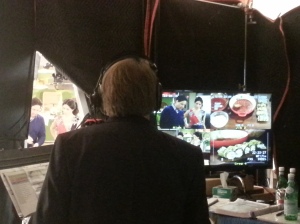
The set we (and other kitchen shows) typically use is the Viking Kitchen Design Showroom. Pretty obvious if you think about it — where else are you going to get a selection of beautiful kitchens with gleaming equipment, just sitting there, waiting to be played with?
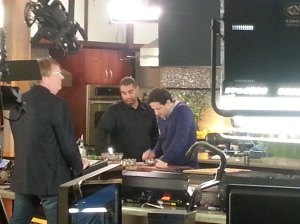 As with almost all of Cook Taste Eat’s videos, this particular shoot predominantly featured Michelin-starred chef Michael Mina (center, in black shirt) and Grammy winner (and supposed voice of the “home cook”) Michelle Branch. When I arrived, they were shooting a “fancy Italian” episode with guest chef Don Pintabona (other guests during the week included Todd English and his forceful eyebrows, among others).
As with almost all of Cook Taste Eat’s videos, this particular shoot predominantly featured Michelin-starred chef Michael Mina (center, in black shirt) and Grammy winner (and supposed voice of the “home cook”) Michelle Branch. When I arrived, they were shooting a “fancy Italian” episode with guest chef Don Pintabona (other guests during the week included Todd English and his forceful eyebrows, among others).
We mostly hid behind a curtain, where the producer/director was calling the shots and monitoring the four cameras being used to shoot the scenes. There was a lot of stop-and-go, and of course the videos were all shot out of order, with the Intros (“here’s what we’ll be making today”) done at the very end once all the beautiful dishes have been cooked and plated. A common problem — which I’ve previously heard with shooting kitchen tv — was that the food was almost always too hot to eat right away, so there was some waiting around for that as well. And, depending on the camera angles, there was a lot of repetition of those seemingly mundane shots that are, in fact, quite crucial to a beautiful and comprehensive video — Michael was asked to open the oven, slide in the eggplant parmesan, and then close the oven, about three times.
All in all, interesting to see. Most fascinating to me was the “real” kitchen, where the mise en place preparation (those little glass bowls of “1 tablespoon of garlic, chopped” don’t appear by themselves) as well as the “swap-out” dishes are made. (We don’t have time to sit around and wait for the eggplant to cook for an hour, so after Michael slides the uncooked one into the oven for the third time, it’s replaced with a cooked bubbly version that will be slid out at the precise “ding” of the timer.) 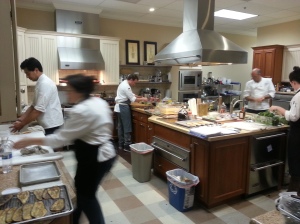
One of Cook Taste Eat’s interns also sat behind the producer, frantically taking notes on her laptop as each chef changed his/her recipe willy-nilly (“Oh, did i tell you guys 1/2 teaspoon of oregano? I meant 1/4. And change the oil to grapeseed; olive oil is gonna burn too quickly on the home stove.”) Apparently any recipe changes need to be made asap by our team before being forwarded to the official Recipe Writer — what a fun job — who will make it all sound glorious, and accurate, just in time for the release of the videos. (Sidenote: I recently read in Harvard Magazine that one of the premier cookbook writers in the industry is a Harvard Law grad. Must connect with him to figure out how he got into that business.)
The shoot was cool, for about half an hour. Then I wandered off to see some of the other show kitchens. There’s pretty much a kitchen for every type of chef. (I can just hear Guy Fieri saying something stupid in the first one with the checkered floor.) Sorry the photos are dark; there were no windows. These kitchens are fake, after all 🙂
The Most Delicious Ethical Dilemma
(Photo courtesy of http://www.freedomandprosperity.org. I have no idea what kind of website that is.)
Forgot to mention one point about my chocolate hazelnut mousse cake. While you can’t tell from the photo of the cake from my previous post, I actually really fucked up my ganache by overcooking it (yes, that’s possible even in a bainmarie). What can I say, chocolate just burns way way easily. Anyhow, the result was a ganache that was neither velvety nor shiny — the hallmarks of a properly-made ganache — and also had a slightly burnt, bitter taste. Personally, I am not a chocolate fan, so I actually preferred the taste — like super dark chocolate — particularly when paired with the sickeningly sweet layers of butter cake and mousse. (And, as you could see from the photo, it still worked out just fine.)
Chef D, however, hated it. Screeching that it was an “ethical dilemma” to allow me to use my ganache on the cake and still get a passing grade, she finally settled on letting me use it but putting the word “BURNT BADLY” in capital letters next to my score sheet. (I still got an A for the course though :)) I dismissively laughed off Chef D’s internal moral struggle, at which point she proceeded to tell me that, “No, really, this is a serious ethical problem. If I told the other pastry chefs that I let you use burnt ganache on a cake, I could get in real trouble as an instructor here.”
Given that the last “serious ethical problem” I came in contact with in my prior profession involved criminal sanctions and potential disbarment (and of course the latter is way worse), I have to say I’ll take the burnt chocolate any day.
